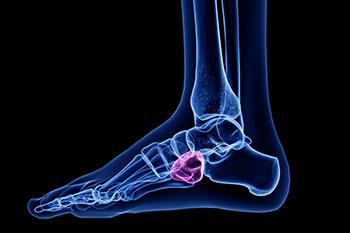
The location of the cuboid bone is on the outside of the foot. When this bone becomes fractured or injured it is referred to as cuboid syndrome. The cuboid bone is the only part of the foot that supports the fourth and fifth toes which significantly contribute to foot movements. Many people who suffer from a cuboid fracture may experience mobility problems and they may have a limited range of motion. This can make it difficult to complete everyday activities and the fracture site may become bruised or appear swollen. Balance may be affected and specific stretches and exercises may need to be performed to improve flexibility and strength of the overall foot. Cuboid syndrome or a fracture may lead to the development of degenerative arthritis. This may be a result of a loss or damage that has been done to the cartilage and the bones may rub together. This can be a serious foot condition. If you are afflicted with foot pain and think it may be cuboid syndrome, please consult with a podiatrist who can offer you the best treatment methods.
Cuboid syndrome, also known as cuboid subluxation, occurs when the joints and ligaments near the cuboid bone in the foot become torn. If you have cuboid syndrome, consult with one of our podiatrists from Romeo Foot & Ankle Clinic. Our doctors will assess your condition and provide you with quality foot and ankle treatment.
Cuboid syndrome is a common cause of lateral foot pain, which is pain on the outside of the foot. The condition may happen suddenly due to an ankle sprain, or it may develop slowly overtime from repetitive tension through the bone and surrounding structures.
Causes
The most common causes of cuboid syndrome include:
- Injury – The most common cause of this ailment is an ankle sprain.
- Repetitive Strain – Tension placed through the peroneus longus muscle from repetitive activities such as jumping and running may cause excessive traction on the bone causing it to sublux.
- Altered Foot Biomechanics – Most people suffering from cuboid subluxation have flat feet.
Symptoms
A common symptom of cuboid syndrome is pain along the outside of the foot which can be felt in the ankle and toes. This pain may create walking difficulties and may cause those with the condition to walk with a limp.
Diagnosis
Diagnosis of cuboid syndrome is often difficult, and it is often misdiagnosed. X-rays, MRIs and CT scans often fail to properly show the cuboid subluxation. Although there isn’t a specific test used to diagnose cuboid syndrome, your podiatrist will usually check if pain is felt while pressing firmly on the cuboid bone of your foot.
Treatment
Just as the range of causes varies widely, so do treatments. Some more common treatments are ice therapy, rest, exercise, taping, and orthotics.
If you have any questions, please feel free to contact one of our our offices located in Washington, and Shelby Townships, MI . We offer the newest diagnostic and treatment technologies for all your foot care needs.
